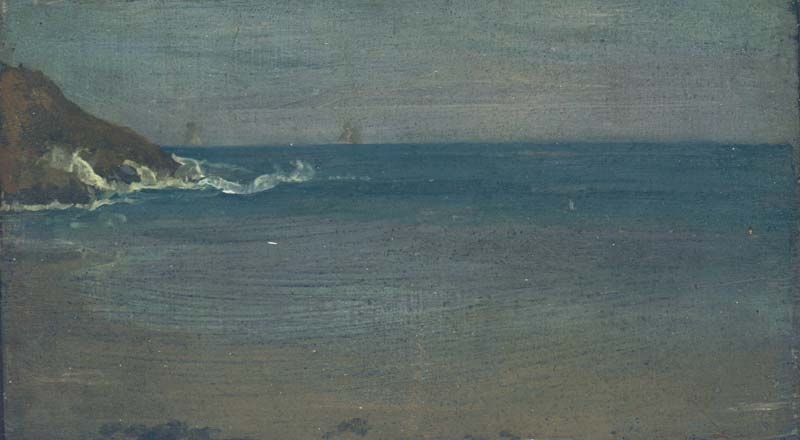Home > Catalogue > Browse > Cliffs and Breakers << >>
Composition
It was compared by Dennis Farr with one of the few paintings by Walter Sickert to have survived from the time he was with Whistler at St Ives - Clodgy Point. It shows close similarities of colour and technique to Whistler's painting. 1
Technique
It was painted on a single section of timber, edged with a narrow band of bevelled, mitred beading. The ground appears to be a dark grey paint, on top of the original priming.
The paint layer was, according to a conservator, 'deliberately thinned and abraded by the artist.' 2 The horizontal panel is rather dark, with a matt silver sky and ochre coloured beach, a sombre green headland, and the well-worked sea lightened by a wrinkled ribbon of white surf, painted with a very small brush. Many of the brushstrokes sweep right across the panel from left to right, the colours blending smooth, silky, harmony in the shallows and on the beach itself.
Conservation History
The painting was treated by Harry Woolford in about 1980, possibly touching up an area at upper left. The condition of the panel was checked by Claire Meredith in 2001, and found to be 'stable and generally sound', with rather thick and slightly discoloured varnish. 3
Frame
Dowdeswell frame, made for exhibition in 1884; 36.4 x 44.9 x 2.5 cm. 4
Notes:
1: Pickvance, Ronald, James McNeill Whistler (1834-1903): An Exhibition of Works from the University of Glasgow Collection, Nottingham University Art Gallery, Nottingham, 1970, p. 50.
2: Condition report by Clare Meredith, 23 April 2001, Hunterian files.
3: Meredith, 23 April 2001, op. cit.
4: Dr S. L. Parkerson Day, Report on frames, 2017; see also Parkerson 2007 [more].
Last updated: 23rd May 2021 by Margaret







